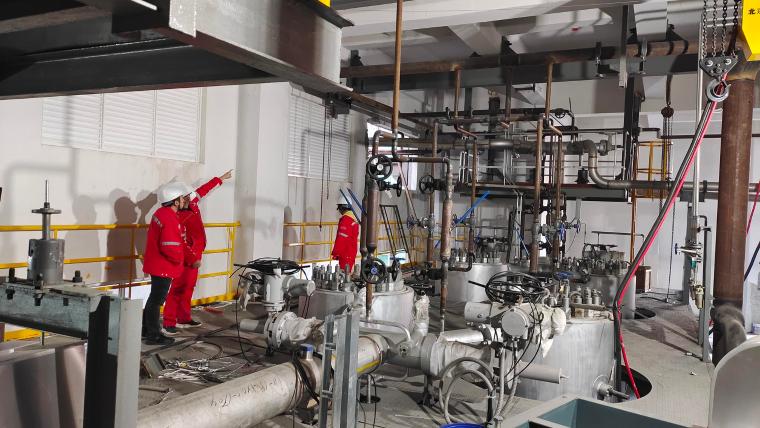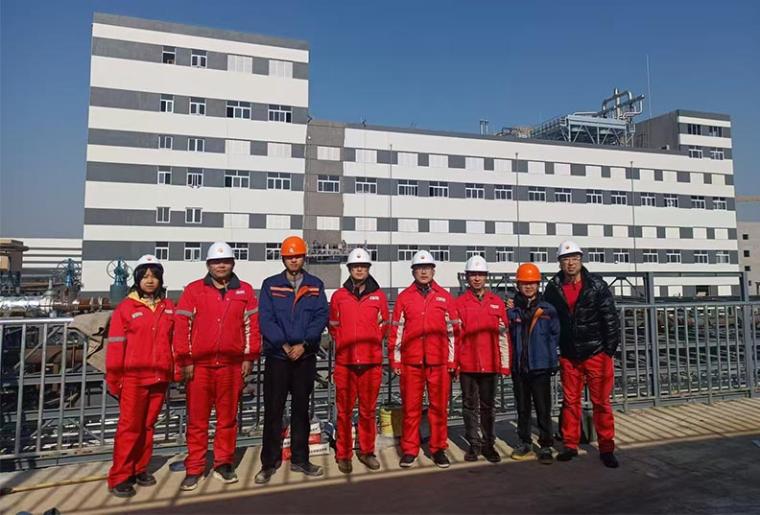The ZCP13 cationic polyester plant of Zhonghong has been fed and started up
On February 15th, the 250,000-ton cationic polyester plant of Zhonghong ZCP13 of Xin Fengming Group, which was undertaken by China Kunlun Engineering Co., Ltd. and participated in by its Shenyang, Liaoyang and Liaojin branches, successfully started up with feedstock. All the indicators of the first batch of products fully met the standards. This marks another "national treasure" in China's high-end fiber materials field, and it has set a new record for the construction of similar facilities with the "Kunlun Speed", being hailed by the owner as a "textbook-level engineering model".

As a benchmark project in China with an annual production capacity of 250,000 tons of fiber-grade cationic modified polyester products, the Zhonghong ZCP13 facility shoulders the strategic mission of promoting the upgrading of new textile materials. Cationic polyester adopts the direct esterification and continuous polycondensation process technology route. The production process is complex and requires precise control of esterification, polycondensation and other reaction processes under high temperature and high pressure conditions. Geng Zhangqiang, the project manager of Kunlun Engineering Company, said that the device consists of five reactors and over 200 dynamic and static equipment, with a crisscrossing pipeline system. The design difficulty can be regarded as the "peak" of the industry.

Facing an extremely tight schedule, the project team of Kunlun Engineering Shenyang Company launched a tough battle with an attitude of "starting with a sprint" within the tight design cycle. The design of the 23,000-meter pressure pipeline system for the entire device has been completed, covering the three core sections of esterification, pre-polycondensation, and final polycondensation. This is equivalent to completing 120% of the workload in 60% of the time required for a conventional project.
When the task was received, a battle against time quietly began. The project formed a cross-departmental task force, breaking down the design tasks into three major battles: process pipeline optimization, 3D model construction, and precise material submission. The design team creatively adopted the "rolling delivery" model, dividing the 23,000-meter pressure pipeline of the device into five layers for simultaneous advancement, and achieving dynamic matching between the 3D model and the construction progress through PDMS.

To break through the project's maximum construction period, the project team entered a "wartime state" from the very beginning of its launch. The design team divided the pipeline system of the device into three major sections: the main process flow, public utilities, and heat medium engineering. By adopting the strategy of "modular design + rolling delivery", they achieved efficient collaboration through batch submission of drawings, segmented procurement of materials, and interwoven advancement of construction.
It is precisely because of this "5+2" and "day and night" spirit of hard work that the team completed all 2,800-plus drawings on schedule and delivered them in batches. The material list for 23,000 meters of pipelines was also submitted for procurement in batches on time, thus winning precious time for on-site construction.
The construction site is also witnessing the "Kunlun Speed". In response to the challenges of tight space and frequent cross-operation within the building, the design team dispatched one key member to the site on a regular basis. Other members promptly cooperated and carried out "daily settlement" style coordination with the construction party to jointly solve technical problems such as pipe gallery collisions and positioning of supports and hangers, ensuring that the project was implemented without any errors.
As a model project of the "corporate integration" strategy of Kunlun Engineering, the ZCP13 device demonstrates the effectiveness of group operations. This project fully leveraged the advantages of group operations. The pipeline specialty worked closely with the process, structure, equipment, automatic control, electrical and other related specialties of Kunlun Engineering Company, as well as the Liaoyang and Liaojin branches, to promptly address key issues such as interface division. In the optimization of the layout of the core area of the device, Kunlun Engineering Company sent experts to the site in person to guide the project team and supervise the core issues.

What is more worth noting is that the entire project was carried out using the digital delivery platform independently built by Kunlun Engineering, which realized the project cycle management of the pipe component library and stress calculation model. This not only ensured the project progress but also formed a replicable standardized operation process, saving at least 30% of the design time for subsequent similar projects.
With the successful operation of the ZCP13 device, in the silver veins of the pipeline system, the wisdom and hard work of Kunlun engineers flow, and it also pulsates with the strong pulse of the upward breakthrough of the national chemical fiber industry. Looking to the future, this team, which is good at fighting tough battles and dares to forge new paths, will continue to depict the pipeline network with craftsmanship and build the monument of engineering with wisdom.
